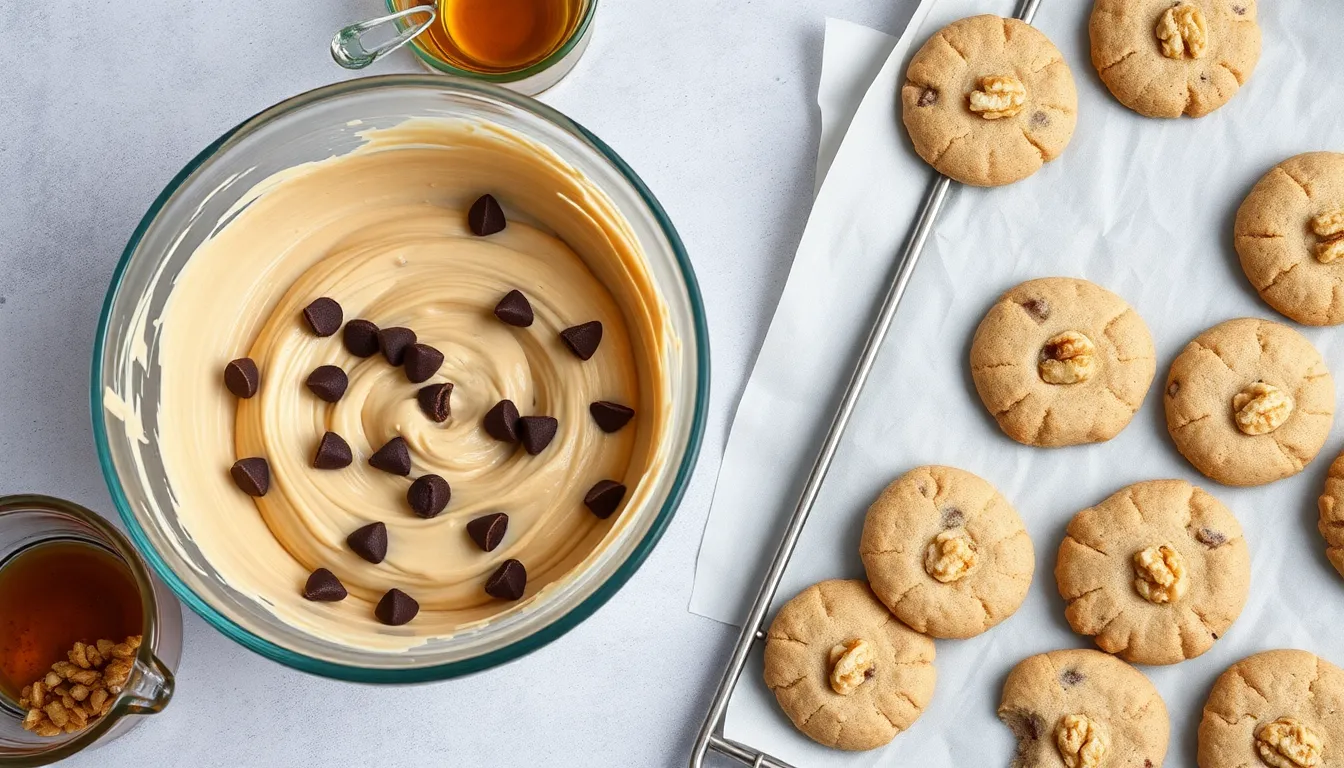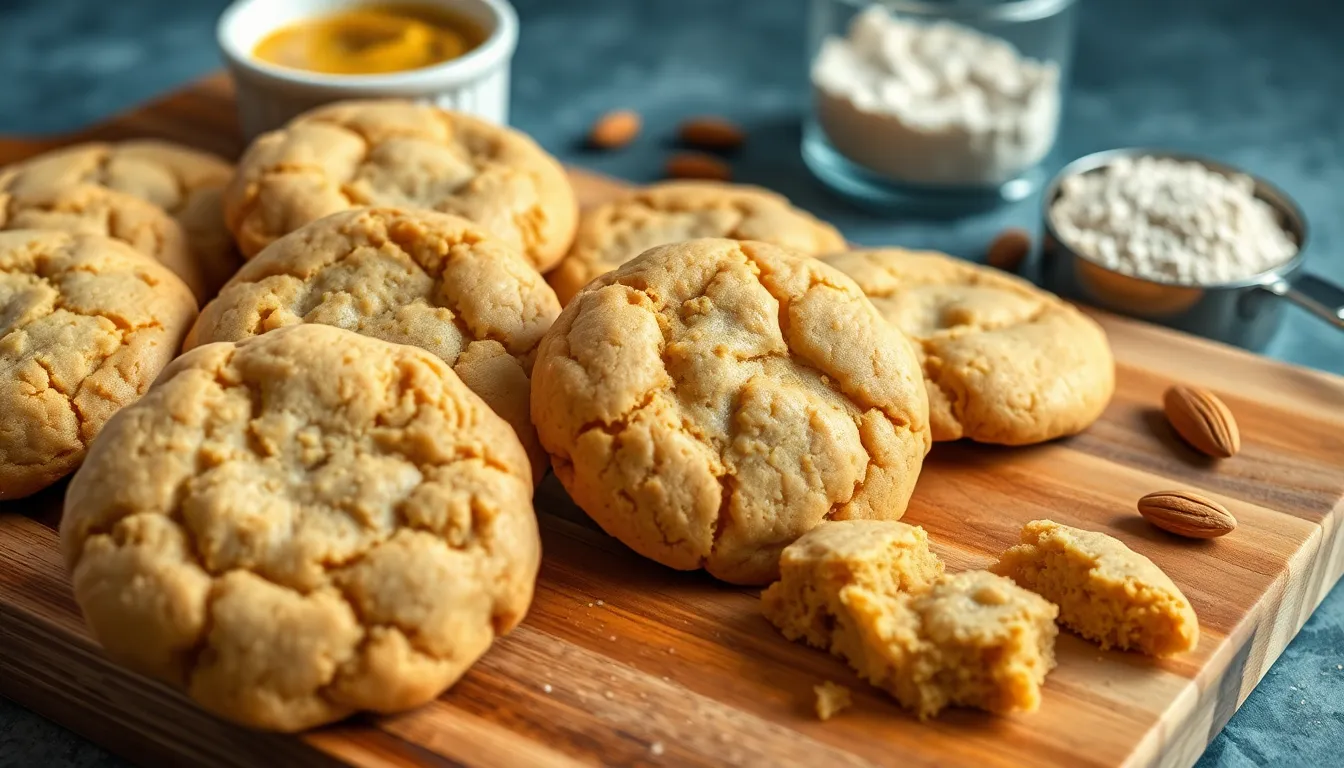We’ve discovered the perfect way to transform humble tahini into irresistible cookies that’ll have everyone asking for the recipe. These tahini cookies blend the rich, nutty flavor of sesame seed paste with just the right amount of sweetness to create something truly special.
What makes these cookies so addictive is their unique texture – they’re soft and chewy on the inside with slightly crispy edges that give way to an incredibly satisfying bite. The tahini doesn’t just add flavor; it creates an almost fudgy consistency that’s completely different from traditional cookies.
We love how simple these are to make, requiring just a handful of pantry staples you probably already have on hand. Whether you’re already a tahini enthusiast or you’re curious about exploring Middle Eastern flavors in your baking, these cookies offer the perfect introduction to this versatile ingredient. They’re also naturally dairy-free, making them a crowd-pleaser for various dietary preferences.
Ingredients
We’ve carefully selected each ingredient to create the perfect balance of nutty richness and sweetness in these tahini cookies. Our ingredient list focuses on pantry staples that work together to achieve that signature soft and chewy texture with crispy edges.
For the Cookies
- 1/2 cup well-stirred tahini (sesame seed paste)
- 1/2 cup packed light brown sugar
- 1/4 cup granulated sugar
- 1 large egg at room temperature
- 1 teaspoon vanilla extract
- 1 cup all-purpose flour
- 1/2 teaspoon baking soda
- 1/4 teaspoon salt
- 2-3 tablespoons whole milk or plant-based milk (as needed)
For Optional Toppings
- 2 tablespoons sesame seeds for sprinkling
- 1/4 cup mini chocolate chips
- 1 tablespoon flaky sea salt for finishing
- 2 tablespoons chopped pistachios
- 1 tablespoon honey for drizzling after baking
Equipment Needed

Making our tahini cookies requires only standard kitchen tools that most home bakers already have on hand. We recommend having several mixing bowls available to keep our wet and dry ingredients organized during preparation.
An electric mixer makes creaming the butter and sugars effortless, though a sturdy hand whisk works perfectly well if you prefer mixing by hand. Accurate measuring cups and spoons ensure our cookies turn out with the ideal texture and flavor balance every time.
A wooden spoon becomes essential for folding in the flour mixture and any optional add-ins like chocolate chips or sesame seeds. We always line our baking sheets with parchment paper to prevent sticking and ensure easy cleanup.
| Equipment | Purpose | Alternative Options |
|---|---|---|
| Electric mixer | Cream butter and sugars | Hand whisk |
| Mixing bowls | Organize ingredients | Any clean bowls |
| Measuring tools | Accurate portions | Kitchen scale |
| Wooden spoon | Fold ingredients | Rubber spatula |
| Baking sheets | Cookie base | Any flat baking pan |
| Parchment paper | Non-stick surface | Silicone mats |
An ice cream scoop creates perfectly uniform cookie portions, though shaping the dough by hand works just as well for a more rustic appearance. Our standard home oven set to 160-180°C (320-350°F) provides the ideal baking environment for achieving those signature soft centers with lightly golden edges.
The beauty of tahini cookies lies in their simplicity, requiring no specialized equipment beyond what we typically use for everyday baking projects.
Instructions

We’ll guide you through each step to create these irresistible tahini cookies with their signature soft centers and crispy edges. The process is straightforward and rewarding for bakers of all skill levels.
Prep the Dough
Begin by whisking together tahini, maple syrup, and almond extract in a large bowl until smooth and well combined. Add the egg and vanilla extract to the mixture, stirring thoroughly to incorporate all wet ingredients.
In a separate bowl, whisk together the all-purpose flour, baking soda, and salt until evenly distributed. Gradually add this dry mixture to the tahini mixture, mixing until just combined to avoid overworking the dough.
Fold in any desired add-ins such as chocolate chips or chopped walnuts at this stage. For enhanced flavor and texture, consider refrigerating the dough overnight, though this step is optional.
Shape the Cookies
Divide the prepared dough into 12 equal portions for consistent baking results. Roll each portion between your palms to form smooth balls.
For an authentic touch, roll the dough balls in toasted sesame seeds to create a delicious coating that adds extra nutty flavor and visual appeal. Place the shaped cookies on a parchment-lined baking sheet, ensuring approximately 2 inches of space between each cookie to allow for spreading during baking.
Bake the Cookies
Preheat your oven to 350°F (175°C) while you finish shaping the cookies. Bake the cookies for approximately 12 minutes, watching carefully until the edges become lightly golden brown.
The centers should still appear slightly soft when you remove them from the oven, as they will continue cooking from residual heat. Avoid overbaking to maintain the desired chewy texture.
Cool and Finish
Allow the cookies to rest on the baking sheet for 10 minutes after removing them from the oven. This cooling period helps them set properly and prevents breaking when transferred.
Transfer the cookies to a wire cooling rack to cool completely before serving. The cookies will develop their perfect texture balance during this final cooling phase, creating the ideal contrast between crispy edges and soft centers.
Directions for Storage

We recommend storing your freshly baked tahini cookies properly to maintain their signature soft and chewy texture. These nutty treats can be preserved using several effective methods depending on how long you plan to keep them.
Room Temperature Storage
Our tahini cookies stay fresh when stored in an airtight container at room temperature for up to 5 days. We suggest keeping them in a cool dry place away from direct sunlight to prevent the tahini oils from becoming rancid. Layer the cookies between sheets of parchment paper or wax paper to prevent them from sticking together and losing their distinct texture.
Refrigerated Storage
After the initial 3 to 5 days at room temperature we can extend the cookies’ shelf life by transferring them to the refrigerator. This method adds another full week to their freshness keeping them enjoyable for up to 12 days total. We place the airtight container in the main body of the refrigerator rather than the door to maintain consistent temperature.
Freezer Storage
For longer preservation we freeze our tahini cookies in airtight containers or freezer bags for up to 3 months. Some sources indicate they can last 8 to 12 months in the freezer though we find optimal quality within the first three months. We separate cookie layers with parchment paper before sealing to prevent freezer burn and maintain individual cookie integrity.
| Storage Method | Duration | Location |
|---|---|---|
| Room Temperature | 3-5 days | Cool, dry place |
| Refrigerated | Additional 7 days | Main refrigerator compartment |
| Frozen | 3 months (optimal) | Freezer in airtight container |
| Extended Frozen | 8-12 months | Freezer in sealed container |
Thawing Instructions
We thaw frozen tahini cookies by leaving them at room temperature for several hours or overnight. This gradual thawing process helps restore their original texture without creating moisture buildup that could make them soggy. We avoid using heat or microwaving as this can alter the delicate balance between the crispy edges and soft centers that make these cookies special.
Make-Ahead Tips

We love how tahini cookies can be prepared well in advance to save time during busy baking sessions. Our make-ahead strategy centers on proper dough preparation and strategic freezing techniques that preserve the cookies’ signature texture and nutty flavor.
Preparing Cookie Dough in Advance
We recommend preparing the cookie dough up to three days ahead of your planned baking time. After mixing all ingredients according to our recipe instructions, shape the dough into a tight log and wrap it securely with plastic wrap. This method prevents air exposure and maintains the dough’s moisture content while developing deeper flavors.
For optimal results, we store the wrapped dough log in the refrigerator where it stays fresh and workable. The chilling process actually improves the final cookie texture by allowing the tahini oils to solidify slightly and the flour to fully hydrate.
Freezing Raw Cookie Dough
We’ve found that freezing cookie dough offers the most flexibility for spontaneous baking sessions. Shape your prepared dough into individual cookie balls and arrange them on a parchment-lined baking sheet. Place the entire sheet in the freezer until the dough balls become completely solid, which typically takes 2 to 3 hours.
Once frozen solid, we transfer the cookie balls to freezer-safe bags or airtight containers. This method prevents the dough balls from sticking together and allows us to bake exactly the number of cookies we need. Raw cookie balls coated with sesame seeds freeze particularly well and can be stored for up to 6 months without losing quality.
Storage Guidelines for Cookie Dough
| Storage Method | Location | Duration | Best Practices |
|---|---|---|---|
| Shaped dough log | Refrigerator | 3 days | Wrap tightly in plastic wrap |
| Raw cookie balls | Freezer | 6 months | Freeze on sheet first, then transfer to bags |
| Frozen dough log | Freezer | 3 months | Double wrap for extra protection |
Thawing and Baking Frozen Dough
We thaw frozen cookie dough in the refrigerator overnight for best results. This gradual thawing process prevents condensation from forming on the dough surface and maintains the proper consistency for baking. Frozen cookie balls can go directly from freezer to oven with just 1 to 2 additional minutes added to the standard baking time.
Our experience shows that cookies baked from frozen dough often have even better texture than those made from fresh dough. The extended chilling time allows the tahini to fully integrate with other ingredients, resulting in more pronounced nutty flavors and improved structural integrity during baking.
Serving Suggestions

We love serving tahini cookies as versatile treats that complement various occasions and pairings. These nutty cookies work beautifully as an afternoon snack alongside a cup of coffee or tea, where their rich sesame flavor provides a sophisticated alternative to traditional sweets.
For special presentations, we recommend garnishing the cookies with flaky sea salt while they’re still warm. The salt crystals create a delightful contrast that enhances the tahini’s nuttiness and adds visual appeal. Extra chocolate chips pressed gently onto the surface before serving also elevate the cookies’ appearance and provide bursts of sweetness.
Fresh and dried fruit make excellent companions to tahini cookies. We particularly enjoy pairing them with pomegranate arils for their festive color and tart pop that balances the cookies’ richness. When pomegranate is out of season, dried currants, cherries, or cranberries serve as wonderful substitutes that add chewy texture and natural sweetness.
Creating an elegant dessert platter becomes effortless when we dust the cookies with a light sprinkle of cinnamon. This aromatic spice complements the sesame notes while adding warmth and depth to each bite. The cinnamon also creates an attractive finish that makes the cookies suitable for entertaining.
We often serve these cookies at room temperature to fully appreciate their soft centers and crispy edges. But, they also taste delicious when slightly warmed, which intensifies the tahini aroma and makes them feel more indulgent. Arranging them on a wooden board with nuts, dried fruits, and a small bowl of honey for drizzling creates an impressive Middle Eastern inspired spread that guests always appreciate.
Recipe Variations

The beauty of tahini cookies lies in their adaptability to different flavor profiles and dietary preferences. We can easily transform our basic recipe into exciting variations that cater to various tastes and needs.
Chocolate Chip Tahini Cookies
Chocolate chip tahini cookies combine the rich sesame flavor with sweet chocolate pieces for an irresistible treat. We fold 1/2 cup of mini chocolate chips into our standard tahini cookie dough after combining the wet and dry ingredients. The chocolate chips create delightful pockets of sweetness that complement the nutty tahini base perfectly. David Lebovitz’s recipe demonstrates how this combination of tahini, sugar, butter, and chocolate chips creates cookies with incredible depth of flavor. We recommend using mini chocolate chips rather than regular sized ones to ensure even distribution throughout each cookie.
Sesame Seed Tahini Cookies
Sesame seed tahini cookies amplify the nutty flavor profile by incorporating whole sesame seeds into the dough. We add 2 tablespoons of toasted sesame seeds directly to our cookie dough for enhanced texture and visual appeal. Rolling the shaped cookie balls in additional sesame seeds before baking creates a beautiful golden coating that adds satisfying crunch. The extra sesame seeds intensify the tahini flavor while providing delightful textural contrast to the soft cookie interior. We toast the sesame seeds in a dry skillet for 2-3 minutes until fragrant to maximize their nutty flavor contribution.
Vegan Tahini Cookies
Vegan tahini cookies eliminate dairy products and eggs while maintaining the signature rich flavor and texture. We replace the egg with 1 tablespoon of ground flaxseed mixed with 3 tablespoons of water, allowing the mixture to gel for 5 minutes before adding. Maple syrup substitutes for granulated sugar, providing natural sweetness and helping bind the ingredients together. Almond flour replaces a portion of the all-purpose flour to create gluten-free options while adding protein and healthy fats. These plant-based cookies deliver the same satisfying taste and texture as traditional versions without compromising on flavor or quality.
Troubleshooting Tips

Even experienced bakers encounter challenges when making tahini cookies. We’ve compiled the most common issues along with proven answers to help you achieve perfect results every time.
Cookie Spreading Problems
When our cookies spread too much during baking, we recommend chilling the dough for 15-20 minutes before placing it in the oven. Using coconut sugar instead of cane sugar can also reduce excessive spreading. If your cookies still spread beyond your desired shape, try the jar technique: gently jiggle a jar upside-down around the cookies immediately after baking to compact them back into shape.
Dry Cookie Texture
Dry tahini cookies often result from using old or thick tahini. We always use fresh, drippy tahini for the best texture. Measure your almond flour carefully, as too much can create a crumbly consistency. When the dough feels too dry or crumbly, add one teaspoon of almond milk at a time until the mixture holds together properly.
Sticking Issues
Cookies that stick to parchment paper create frustration and broken treats. We solve this problem by lightly oiling our parchment paper before placing the cookie dough. This simple step prevents sticking while maintaining easy cleanup.
Structural Problems
Crumbly cookies that fall apart indicate binding issues in your dough. Adding more eggs helps bind the ingredients together, but we caution against adding too many eggs as this creates cake-like cookies rather than the desired chewy texture.
Texture Concerns
Hard cookies typically result from overbaking or using incorrect oven temperatures. We check our cookies at the minimum baking time and adjust accordingly. Baking at too low a temperature for too long can also create tough cookies.
| Common Issue | Primary Cause | Solution |
|---|---|---|
| Excessive spreading | Warm dough or sugar type | Chill dough 15-20 minutes |
| Dry texture | Old tahini or excess flour | Use fresh tahini, measure carefully |
| Sticking | Inadequate pan preparation | Lightly oil parchment paper |
| Crumbly cookies | Insufficient binding | Add eggs gradually |
| Hard texture | Overbaking | Monitor baking time closely |
Prevention Tips
Using fresh ingredients ensures optimal flavor and texture in every batch. Proper measurement of all ingredients prevents most common cookie problems before they occur. We recommend using a cookie scoop to create uniform cookie sizes, which promotes even baking and consistent results throughout the batch.
Conclusion
These tahini cookies have proven themselves as a delightful addition to any baker’s repertoire. We’ve shown you that with simple pantry ingredients and straightforward techniques you can create cookies that offer something truly special – that perfect balance of nutty richness and sweet satisfaction.
What makes this recipe particularly appealing is its versatility. Whether you’re serving them at a casual gathering or preparing them as make-ahead treats the results consistently deliver that signature texture we all crave.
We encourage you to experiment with the variations and serving suggestions we’ve shared. Each batch offers an opportunity to explore new flavor combinations while maintaining the essential character that makes tahini cookies so irresistible.
Frequently Asked Questions
What are tahini cookies and what makes them special?
Tahini cookies are unique treats made with tahini (sesame seed paste) that offer a rich, nutty flavor with a distinctive texture. They’re soft and chewy on the inside with crispy edges, creating a fudgy consistency unlike traditional cookies. These cookies are naturally dairy-free and provide an accessible introduction to Middle Eastern flavors using simple pantry ingredients.
What ingredients do I need to make tahini cookies?
Essential ingredients include well-stirred tahini, light brown sugar, granulated sugar, an egg, vanilla extract, all-purpose flour, baking soda, and salt. Optional add-ins include sesame seeds, mini chocolate chips, flaky sea salt, chopped pistachios, and honey for drizzling. These ingredients create the perfect balance of nutty richness and sweetness.
What equipment is needed for making tahini cookies?
You’ll need basic kitchen tools: mixing bowls, an electric mixer or hand whisk, accurate measuring tools, and a wooden spoon. An ice cream scoop helps create uniform portions, and parchment-lined baking sheets make cleanup easier. Most home bakers already have these standard items, making this recipe very accessible.
How do I bake tahini cookies properly?
Start by whisking tahini, maple syrup, and almond extract, then add egg and vanilla. Mix dry ingredients separately before combining with wet mixture. Roll dough into balls, optionally coat with sesame seeds, and bake at 350°F (175°C) for about 12 minutes. Cool on baking sheet for 10 minutes before transferring.
How should I store tahini cookies to maintain freshness?
Store cookies in an airtight container at room temperature for up to 5 days, or refrigerate for an additional week. For longer storage, freeze for up to 3 months for optimal quality, or 8-12 months maximum. Use parchment paper to separate layers and thaw at room temperature to restore original texture.
Can I make tahini cookie dough ahead of time?
Yes, prepare dough up to three days in advance by shaping into a log, wrapping in plastic wrap, and refrigerating to enhance flavor. You can also freeze shaped cookie dough balls for up to 6 months. Thaw overnight in refrigerator or bake directly from frozen with slight time adjustments.
What are some good ways to serve tahini cookies?
Tahini cookies pair excellently with coffee or tea. Garnish with flaky sea salt or chocolate chips for extra appeal. Serve with fresh fruits like pomegranate arils or dried currants, dust lightly with cinnamon, and present on wooden boards with nuts and honey for an elegant Middle Eastern-inspired spread.
Are there variations I can try with tahini cookies?
Popular variations include chocolate chip tahini cookies, sesame seed tahini cookies for enhanced nuttiness, and vegan tahini cookies using ground flaxseed and maple syrup substitutes. These adaptations cater to different flavor preferences and dietary needs while maintaining the signature tahini taste and texture.
What should I do if my tahini cookies spread too much or turn out dry?
For spreading issues, chill the dough before baking and ensure fresh ingredients. If cookies are dry, check ingredient measurements and don’t overbake. For sticking problems, lightly oil parchment paper. Proper ingredient preparation and following recommended baking times prevent most common texture and structural issues.







